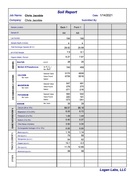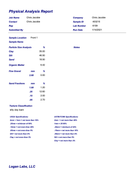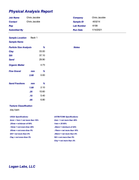2021 will be my first full season caring about and for the lawn. I got interested in lawn care around June of 2020.
I’ve owned this house for 4 years. Until this past year, I hired the cheap mow and blow guys to bag clippings during the summer and pickup leaves in the fall. I irrigated for about 15 minutes (maybe .10" of water) when the yard looked like it might combust if I didn’t. No weed controls were used and I had a pretty big crabgrass infestation this year. Oh and I think the guys I hired might’ve sprayed some nitrogen-only liquid fert a couple times.
This year I put down various fertilizers based on marketing hype + local recommendations, tried my darnedest to irrigate 1" of water per week and mow regularly. I also did a Fall pre-emergent app.
SOIL
I didn’t trust my interpretation of the jar test. I went ahead and had Logan run a physical analysis report (attached.) It’s a “clay loam” in the backyard and a “silty clay loam” in the front.
The percolation test was interesting. In the first hour it drained 8.25”! I checked back about 30-40 minutes later and all the water was gone.
To check for compaction, I pushed a thin, metal marking flag into the ground around the front and back. I could only push it in about 4”.
So it drains super fast but is also possibly compacted? I’m confused.
THE LAWN
The lawn is about 700 sq. ft. in the front and 1200 sq. ft. in the back. It is currently St. Augustine of an unknown variety. There's also a temporary patch of annual ryegrass in the back and a big bare spot in the front.
I’m considering renovating the whole thing with Floratam St. Augustine.
MOWING PRACTICES
With the St. Augustine, I mow at 4” with a rotary mower and mulch the clippings back into the lawn. The annual ryegrass is getting mowed around 3”. Right now I’m mowing the ryegrass once every 5-10 days based on when it needs it and 1/3 rule.
The St. Augustine is currently dormant. During the summer I was mowing 1-2x per week, again based on when it needs it and 1/3 rule. My plan is to mow super often this year to try and keep the crabgrass in check.
IRRIGATION PRACTICES
I have a hose-end rotor sprinkler (Orbit H20-6.)
I base my watering amount on the ET data from Texas ET. The measuring station is about 10 minutes from here so it’s pretty accurate. Plus, I have my own rain gauge to compare their data too.
Right now I’m watering about once a month and in hottest part of the summer it’s 1-2 times per week.
I’m also going to put down a split-app of Hydretain every 6 weeks because we don’t get much rain here. (Only 22 in. last year and most of it out of season.) It also might help with the fast drainage too.
PEST ISSUES
I think I had chinch bug or grub damage in the hottest spot of the backyard last year but I don't know for sure. Could’ve well been a fungal issue as well.
Like I said, I had a big crabgrass infestation last year. I had to manually pull it because, as far as I know, you can’t spray St. Augustine for crabgrass because they’re both wide-bladed grass types. I just put down my pre-emergent (Sunniland’s Dithiopyr 0-0-7) last week as our soil temps crossed the 55* threshold. Hopefully that will help.
APPROACH
I would like the best approach, to address all deficiencies and I would prefer to try and keep things organic if at all possible. I currently have the following products and live in a major city so most things are available.
Organics
- Milo (6-4-0)
- Hi-Yield Iron Plus Soil Acidifier (11-0-0) (Ammonium Sulfate and Iron Oxide according to the label)
- Sunniland Professional Crabgrass Control Pre-Emergent (Dithiopyr + 0-0-7)
Big thank you in advance! This forum rocks!!
Chris
TL:DR
This is my first ever soil test and my first full season of not neglecting my lawn. I want the best possible approach and to start trending in the right direction this year. I’ve attached both my soil reports and physical analysis reports from Logan Labs. Thanks!
Soil Test Results

Physical Test Results (Front)

Physical Test Results (Back)
